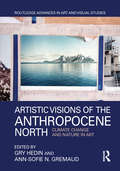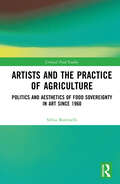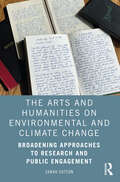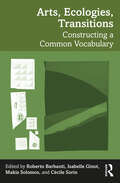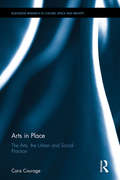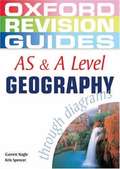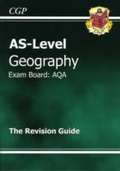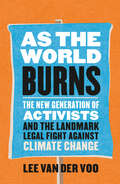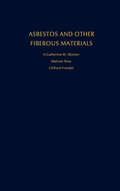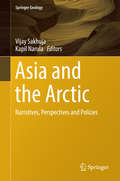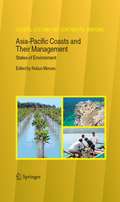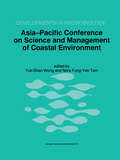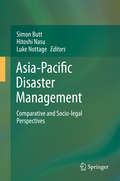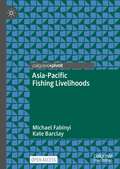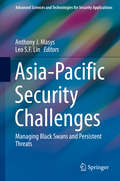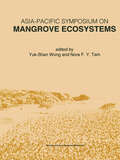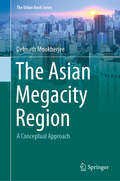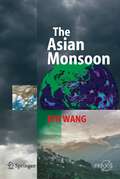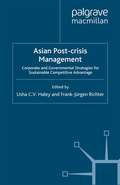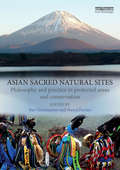- Table View
- List View
Artistic Visions of the Anthropocene North: Climate Change and Nature in Art (Routledge Advances in Art and Visual Studies)
by Gry Hedin Ann-Sofie N. GremaudIn the era of the Anthropocene, artists and scientists are facing a new paradigm in their attempts to represent nature. Seven chapters, which focus on art from 1780 to the present that engages with Nordic landscapes, argue that a number of artists in this period work in the intersection between art, science, and media technologies to examine the human impact on these landscapes and question the blurred boundaries between nature and the human. Canadian artists such as Lawren Harris and Geronimo Inutiq are considered alongside artists from Scandinavia and Iceland such as J.C. Dahl, Eija-Liisa Ahtila, Toril Johannessen, and Björk.
Artists and the Practice of Agriculture: Politics and Aesthetics of Food Sovereignty in Art since 1960 (Critical Food Studies)
by Silvia BottinelliArtists and the Practice of Agriculture maps out examples of artistic practices that engage with the aesthetics and politics of gathering food, growing edible and medicinal plants, and interacting with non-human collaborators. In the hands of contemporary artists, farming and foraging become forms of visual and material language that convey personal and political meanings. This book provides a critical analysis of artistic practices that model alternative food systems. It presents rich academic insights as well as 16 conversations with practicing artists. The volume addresses pressing issues, such as the interconnectedness of human and other-than-human beings, the weight of industrial agriculture, the legacy of colonialism, and the promise of place-based and embodied pedagogies. Through participatory projects, the artists discussed here reflect on the links between past histories, present challenges, and future solutions for the food sovereignty of local and networked communities. The book is an easy-to-navigate resource for readers interested in food studies, visual and material cultures, contemporary art, ecocriticism, and the environmental humanities.
Artists and the Practice of Agriculture: Politics and Aesthetics of Food Sovereignty in Art since 1960 (Critical Food Studies)
by Silvia BottinelliArtists and the Practice of Agriculture maps out examples of artistic practices that engage with the aesthetics and politics of gathering food, growing edible and medicinal plants, and interacting with non-human collaborators. In the hands of contemporary artists, farming and foraging become forms of visual and material language that convey personal and political meanings. This book provides a critical analysis of artistic practices that model alternative food systems. It presents rich academic insights as well as 16 conversations with practicing artists. The volume addresses pressing issues, such as the interconnectedness of human and other-than-human beings, the weight of industrial agriculture, the legacy of colonialism, and the promise of place-based and embodied pedagogies. Through participatory projects, the artists discussed here reflect on the links between past histories, present challenges, and future solutions for the food sovereignty of local and networked communities. The book is an easy-to-navigate resource for readers interested in food studies, visual and material cultures, contemporary art, ecocriticism, and the environmental humanities.
The Arts and Humanities on Environmental and Climate Change: Broadening Approaches to Research and Public Engagement
by Sarah SuttonThe Arts and Humanities on Environmental and Climate Change examines how cultural institutions and their collections can support a goal shared with the scientific community: creating a climate-literate public that engages with environmental issues and climate change in an informed way. When researchers, curators, and educators use the arts and humanities to frame discussions about environmental and climate change, they can engage a far wider public in learning, conversation, and action than science can alone. Demonstrating that archival and object-based resources can act as vital evidence for change, Sutton shows how the historical record, paired with contemporary reality, can create more personal connections to what many consider a remote experience: the changing climate. Providing valuable examples of museum collections used in discussions of environmental and climate change, the book shares how historic images and landscape paintings demonstrate change over time; and how documentary evidence in the form of archaeological reports, ships logs, Henry David Thoreau’s journals, and local reports of pond hockey conditions are being used to render climate data more accessible. Images, personal records, and professional documents have critical roles as boundary objects and proxy data. These climate resources, Sutton argues, are valuable because they make climate change personal and attract a public less interested in a scientific approach. This approach is underused by museums and their research allies for public engagement and for building institutional relevancy. The Arts and Humanities on Environmental and Climate Change will be most interesting to readers looking for ways to broaden engagement with environmental and climate issues. The ideas shared here should also act as inspiration for a broad spectrum of practitioners, particularly those writing, designing, and curating public engagement materials in museums, for wider research, and for the media.
The Arts and Humanities on Environmental and Climate Change: Broadening Approaches to Research and Public Engagement
by Sarah SuttonThe Arts and Humanities on Environmental and Climate Change examines how cultural institutions and their collections can support a goal shared with the scientific community: creating a climate-literate public that engages with environmental issues and climate change in an informed way. When researchers, curators, and educators use the arts and humanities to frame discussions about environmental and climate change, they can engage a far wider public in learning, conversation, and action than science can alone. Demonstrating that archival and object-based resources can act as vital evidence for change, Sutton shows how the historical record, paired with contemporary reality, can create more personal connections to what many consider a remote experience: the changing climate. Providing valuable examples of museum collections used in discussions of environmental and climate change, the book shares how historic images and landscape paintings demonstrate change over time; and how documentary evidence in the form of archaeological reports, ships logs, Henry David Thoreau’s journals, and local reports of pond hockey conditions are being used to render climate data more accessible. Images, personal records, and professional documents have critical roles as boundary objects and proxy data. These climate resources, Sutton argues, are valuable because they make climate change personal and attract a public less interested in a scientific approach. This approach is underused by museums and their research allies for public engagement and for building institutional relevancy. The Arts and Humanities on Environmental and Climate Change will be most interesting to readers looking for ways to broaden engagement with environmental and climate issues. The ideas shared here should also act as inspiration for a broad spectrum of practitioners, particularly those writing, designing, and curating public engagement materials in museums, for wider research, and for the media.
Arts, Ecologies, Transitions: Constructing a Common Vocabulary
by Roberto Barbanti Isabelle Ginot Makis Solomos Cécile SorinArts, Ecologies, Transitions provides in-depth insights into how aesthetic relations and current artistic practices are fundamentally ecological and intrinsically connected to the world. As art is created in a given historic temporality, it presents specific modalities of productive and sensory relations to the world. With contributions from 49 researchers, this book tracks evolutions in the arts that demonstrate an awareness of the environmental, economic, social, and political crises. It proposes interdisciplinary approaches to art that clarify the multiple relationships between art and ecology through an exploration of key concepts such as collapsonauts, degrowth, place, recycling, and walking art. All the artistic fields are addressed from the visual arts, theatre, dance, music and sound art, cinema, and photography – including those that are rarely represented in research such as digital creation or graphic design – to showcase the diversity of artistic practices in transition.Through original research this book presents ideas in an accessible format and will be of interest to students and researchers in the fields of environmental studies, ecology, geography, cultural studies, architecture, performance studies, visual arts, cinema, music, and literature studies.
Arts, Ecologies, Transitions: Constructing a Common Vocabulary
Arts, Ecologies, Transitions provides in-depth insights into how aesthetic relations and current artistic practices are fundamentally ecological and intrinsically connected to the world. As art is created in a given historic temporality, it presents specific modalities of productive and sensory relations to the world. With contributions from 49 researchers, this book tracks evolutions in the arts that demonstrate an awareness of the environmental, economic, social, and political crises. It proposes interdisciplinary approaches to art that clarify the multiple relationships between art and ecology through an exploration of key concepts such as collapsonauts, degrowth, place, recycling, and walking art. All the artistic fields are addressed from the visual arts, theatre, dance, music and sound art, cinema, and photography – including those that are rarely represented in research such as digital creation or graphic design – to showcase the diversity of artistic practices in transition.Through original research this book presents ideas in an accessible format and will be of interest to students and researchers in the fields of environmental studies, ecology, geography, cultural studies, architecture, performance studies, visual arts, cinema, music, and literature studies.
Arts in Place: The Arts, the Urban and Social Practice (Routledge Research in Culture, Space and Identity)
by Cara CourageThis interdisciplinary book explores the role of art in placemaking in urban environments, analysing how artists and communities use arts to improve their quality of life. It explores the concept of social practice placemaking, where artists and community members are seen as equal experts in the process. Drawing on examples of local level projects from the USA and Europe, the book explores the impact of these projects on the people involved, on their relationship to the place around them, and on city policy and planning practice. Case studies include Art Tunnel Smithfield, Dublin, an outdoor art gallery and community space in an impoverished area of the city; The Drawing Shed, London, a contemporary arts practice operating in housing estates and parks in Walthamstow; and Big Car, Indianapolis, an arts organisation operating across the whole of this Midwest city. This book offers a timely contribution, bridging the gap between cultural studies and placemaking. It will be of interest to scholars, students and practitioners working in geography, urban studies, architecture, planning, sociology, cultural studies and the arts.
Arts in Place: The Arts, the Urban and Social Practice (Routledge Research in Culture, Space and Identity)
by Cara CourageThis interdisciplinary book explores the role of art in placemaking in urban environments, analysing how artists and communities use arts to improve their quality of life. It explores the concept of social practice placemaking, where artists and community members are seen as equal experts in the process. Drawing on examples of local level projects from the USA and Europe, the book explores the impact of these projects on the people involved, on their relationship to the place around them, and on city policy and planning practice. Case studies include Art Tunnel Smithfield, Dublin, an outdoor art gallery and community space in an impoverished area of the city; The Drawing Shed, London, a contemporary arts practice operating in housing estates and parks in Walthamstow; and Big Car, Indianapolis, an arts organisation operating across the whole of this Midwest city. This book offers a timely contribution, bridging the gap between cultural studies and placemaking. It will be of interest to scholars, students and practitioners working in geography, urban studies, architecture, planning, sociology, cultural studies and the arts.
AS and A-level Geography Edexcel complete Revision and Practice: Edexcel Complete Revision And Practice
by Cgp BooksThis Edexcel A-Level Geography Complete Revision & Practice book contains everything students need to know for both years of the A-Level course. It's packed with clear study notes, lots of case studies and plenty of exam-style practice for every Edexcel topic - with full answers included. There's also a section of in-depth advice on the skills needed for the exam, plus a breakdown of the exam papers to help students secure top marks on the day! What's more, we've thrown in a free Online Edition that lets you read the entire book on a PC, Mac or tablet. When the book arrives, just use the unique code printed inside the cover to gain full access.
AS and A Level Geography Through Diagrams (Oxford Revision Guides Ser.)
by Garrett Nagle Kris Spencer Oxford StaffExpert authors have taken the content of the AS and A Level specifications and presented them in a refreshingly clear and concise format. Simple illustrations are used to present information in a particularly clear and memorable way, and all content is broken down into short one-page sections.
AS Level Geography AQA Complete Revision & Practice (PDF)
by Cgp BooksThis Revision Guide contains comprehensive study notes for AS-Level Geography, perfectly matched to the AQA specification. Exam-style practice questions are also included for every topic. Everything's presented in an accessible, student-friendly style, with plenty of clear diagrams and a touch of humour.
As the World Burns: The New Generation of Activists and the Landmark Legal Fight Against Climate Change
by Lee van der VooAward-winning investigative journalist Lee van der Voo reports on Juliana v. the United States. Combining unparalleled access to the plaintiffs and reporting on the natural disasters that form an urgent backdrop to the story, van der Voo shares a timely and important story about the environment, the law, and the new generation of activists.
Asbestos and Other Fibrous Materials: Mineralogy, Crystal Chemistry, and Health Effects
by H. Catherine Skinner Malcolm Ross Clifford FrondelThis comprehensive sourcebook describes the chemical, physical, and mineralogical aspects of fibrous inorganic materials, both synthetic and naturally occurring. A general description of the fibrous state, the range of compounds that can adopt this form, and an overview of the characteristics unique to such materials form the backbone of the book . The authors also assess the application and use of asbestos and other fibrous materials in industry and evaluate their potential as health hazards. The information gathered here will be highly useful to medical investigators and legal professionals involved in environmental health.
Asia and the Arctic: Narratives, Perspectives and Policies (Springer Geology)
by Vijay Sakhuja Kapil NarulaThis book presents narratives, perspectives and policies on the Arctic and brings to fore the strategies of five Asian countries - China, India, Japan, Republic of Korea and Singapore who were granted the status of Permanent Observers in the Arctic Council in 2013. The book also captures Arctic countries’ reactions to Asian approaches, and their expectations from these countries. The melting of the polar sea-ice induced by climate change has placed the Arctic region in the forefront of global scientific, economic, strategic and academic interest. The discourse involves a number of issues such as claims of the littoral countries to the continental shelves of the region, the management and exploitation of its living and non-living resources, the rights and interests of indigenous communities, and the prospects of new ice-free shipping routes. The contemporary discourse also suggests that the Arctic region presents challenges and offers opportunities for the international community. These issues have given rise to new geopolitical, geoeconomic, and geostrategic dynamics amongst the Arctic littorals, and led to the growing interest of non-Arctic states in the affairs of the Arctic. It is evident that the Asian countries have a variety of interests in the Arctic, and the grant of Permanent Observer status to these countries is an acknowledgement of their capabilities. These countries are keen to explore opportunities in the Arctic, and have begun to formulate appropriate long-term national strategies. The preliminary approach of the Asian Observer countries has rightly been to graduate from ‘involvement’ to ‘engagement’ in the Arctic, which seems to have generated significant interest amongst analysts. This book helps to understand the approaches of various Arctic and non-Arctic stakeholders, in light of the evolving dynamics in the region.
Asia-Pacific Coasts and Their Management: States of Environment (Coastal Systems and Continental Margins #11)
by Nobuo MimuraThe Asia and Pacific region is home to the world’s largest concentration of coral reefs and mangroves. It accommodates two-thirds of the world’s human population and its economic activities have the highest growth rate in the world. This book gives an overview of the state-of-the-art understanding on the drivers, state, and responses to the coastal environmental changes in the Asia and Pacific region. It provides important perspectives on the subject for researchers.
Asia-Pacific Conference on Science and Management of Coastal Environment: Proceedings of the International Conference held in Hong Kong, 25–28 June 1996 (Developments in Hydrobiology #123)
by Yuk-Shan Yuk-Shan Wong Nora Fung-Yee TamHuman beings have a long historical relationship with the coast. Initially it provided food and security, later forming important locations for industrial and commercial development. Now the emphasis has shifted towards leisure and conservation, although the former functions remain crucial. However, it is only very recently that people have started viewing the coast as a common and valuable resource that requires rational utilisation and scientific management in order to sustain its attractiveness. Of course, enlightened management comes only through understanding of the complicated coastal regions, which enables coastal managers to balance pressures from different sectors and to minimize risks. Scientific knowledge will continue to be the most important basis for resolving the conflicts between coastal users and interest groups such as developers and ecologists. Coastal management has also shifted from traditional restorative or remedial actions towards planned avoidance of other conflicts. Despite rapid advancement in coastal sciences over recent decades, most of the major coastal issues have remained outstanding in the agenda. Control of shoreline erosion and protecting sea level rise continue to be crucial problems facing coastal scientists. Destructive coastal storms still cause tremendous damage, particularly in low altitudes. Wetland and estuary reclamation have led to the loss of the most valuable estuary wetlands which are required to sustain biological productivity and biodiversity. This volume includes papers on marine and coastal pollution, eutrophication, aquaculture, conservation and utilization, coastal wetlands, and coastal zone management.
Asia-Pacific Disaster Management: Comparative and Socio-legal Perspectives
by Simon Butt Hitoshi Nasu Luke NottageThe book outlines the regulatory environment for disaster prevention and management in broad social, economic and political context. The first half of the book focuses mainly on Japan, especially the ‘3-11’ events: the earthquake and tsunami that devastated the Tohoku area on 11 March 2011 and the Fukushima Daiichi nuclear power plant radiation leaks. The second half focuses on the USA (the only other Asia-Pacific country to have experienced a serious nuclear emergency), Indonesia, China, New Zealand, Australia and international law. One question explored is whether socio-legal norms play different roles in preventing and managing responses to natural disasters compared to ‘man-made’ disasters. Another is how ‘disaster law’ interacts with society across very diverse societies in the disaster-prone Asia-Pacific region. The book also addresses the increasingly important roles played by international law and regional regimes for cross-border cooperation in disaster prevention and relief, including the functions played by military forces.Erudite, pragmatic, and charged with detailed, substantive knowledge of an astonishing range of contexts and research fields, this timely collection of important essays on the law and society of disaster management stands as an exemplary international academic response to the disasters of 11 March 2011. (Annelise Riles)
Asia-Pacific Fishing Livelihoods
by Michael Fabinyi Kate BarclayThis open access book explores fishing livelihoods in the context of the wider contexts in which they are embedded. Drawing on case studies from across the Asia-Pacific region, the book highlights how fishing livelihoods are shaped by globalisation, social relationships and governance. The book concludes by showing how better understanding these relationships can contribute to governance for healthier ecosystems and social wellbeing.This is an open access book.This is an open access book.
Asia-Pacific Security Challenges: Managing Black Swans and Persistent Threats (Advanced Sciences and Technologies for Security Applications)
by Anthony J. Masys Leo S.F. LinThis edited book examines the contemporary regional security concerns in the Asia-Pacific recognizing the ‘Butterfly effect’, the concept that small causes can have large effects: ‘the flap of a butterfly’s wings can cause a typhoon halfway around the world’. For many Asia-Pacific states, domestic security challenges are at least as important as external security considerations. Recent events (both natural disasters and man-made disasters) have pointed to the inherent physical, economic, social and political vulnerabilities that exist in the region. Both black swan events and persistent threats to security characterize the challenges within the Asia-Pacific region. Transnational security challenges such as global climate change, environmental degradation, pandemics, energy security, supply chain security, resource scarcity, terrorism and organized crime are shaping the security landscape regionally and globally. The significance of emerging transnational security challenges in the Asia-Pacific Region impact globally and conversely, security developments in those other regions affect the Asia-Pacific region.
Asia-Pacific Symposium on Mangrove Ecosystems: Proceedings of the International Conference held at The Hong Kong University of Science & Technology, September 1–3, 1993 (Developments in Hydrobiology #106)
by Yuk-Shan Yuk-Shan Wong Nora F. Y. TamMangrove ecosystems are typical formations found in coastal deposits of mud and silt throughout the tropics and some distance into the subtropical latitudes. The total wordwide mangrove area, which is estimated at about 170,000 km2 with some sixty species of trees and shrubs exclusive to the habitat, dominates approximately 75% of the world's coastline between latitudes 25°N and 25°S. Such unique intertidal ecosystems support genetically diverse communities of terrestrial and aquatic organisms that are of direct or indirect socioeconomic values. Mangrove forests play important roles as coastal stabilization and protection against winds and storms; producers of nutrients, forest resources and animal species of economic importance. Recently, the issues on the conservation, proper utilization and management of mangrove forests have been widely discussed. Unfortunately, overexploitation and destruction of mangroves seriously threatens the sustainability of such a unique ecosystem. This volume includes papers on three main areas: recent advances in mangrove ecology; application and utilization of mangrove resources; and conservation and management of the ecosystems.
The Asian Megacity Region: A Conceptual Approach (The Urban Book Series)
by Debnath MookherjeeThis book argues that close and disciplined scrutiny of the Asian megacity regions is of critical importance to understanding Asian urbanization. However, any approach to studying these regions must adopt a multi-dimensional and trans-urban perspective; otherwise, we Without such an approach, we cannot truly make meaningful decisions about growth management and sustainable development for such regions. Amidst the sweeping demographic and structural shifts produced by global urbanization, Asian urbanization has a fascinating and prominent role. Asian urbanization is heterogeneous, and more accurately constitutes “phenomena” than a “phenomenon.” However, despite this diversity, there are certain common features that we can identify. One of them is the Asian “megacity region”— the administrative and/or delineated territory of mixed urban-rural landscape surrounding a giant metropolis.The purpose of this book is to: Understand the main features of 21st century urbanization Note the limitations of current approaches (e.g. disparate scales, city-centric views, inadequate data sets)Articulate a pragmatically framed three-pronged approach (scale-based, trans-urban, multi-dimensional)Demonstrate the application of such an approach with a case study of one of the most important megacity regions in South Asia, the Delhi National Capital Region, underscoring the methodological requirements of such an approach Discuss the next steps for the field as a whole: questions to be raised and directions to be explored for further study. This timely, conceptual and empirical book will appeal to students of urbanization, architects involved in urban policy and planning, and researchers alike.
The Asian Monsoon (Springer Praxis Books)
by Bin WangThis is a timely, interdisciplinary scientific overview of the atmosphere, the ocean and the land surface as it interacts with physical, chemical and biological processes. The high level of detail sets it apart from other studies of monsoon meteorology. The text includes analysis of paleoclimate records, human influences on the monsoon climate and the economic impacts of the monsoon on economies and to human health.
Asian Post-crisis Management: Corporate and Governmental Strategies for Sustainable Competitive Advantage
by U. Haley F. RichterThis book examines the key issues faced by the managers of multinational companies, and contains cutting-edge strategies and practices designed to enable managers and policy makers to weather the Asian financial and economic storms. Asian Post-Crisis Management shows how to position companies and governments in Asia for sustainable competitive advantage, and will be of interest to top management leaders, senior economic analysts, policy makers, academic scholars and students of international management.
Asian Sacred Natural Sites: Philosophy and practice in protected areas and conservation
by Bas Verschuuren Naoya FurutaNature conservation planning tends to be driven by models based on Western norms and science, but these may not represent the cultural, philosophical and religious contexts of much of Asia. This book provides a new perspective on the topic of sacred natural sites and cultural heritage by linking Asian cultures, religions and worldviews with contemporary conservation practices and approaches. The chapters focus on the modern significance of sacred natural sites in Asian protected areas with reference, where appropriate, to an Asian philosophy of protected areas. Drawn from over 20 different countries, the book covers examples of sacred natural sites from all of IUCN’s protected area categories and governance types. The authors demonstrate the challenges faced to maintain culture and support spiritual and religious governance and management structures in the face of strong modernisation across Asia. The book shows how sacred natural sites contribute to defining new, more sustainable and more equitable forms of protected areas and conservation that reflect the worldviews and beliefs of their respective cultures and religions. The book contributes to a paradigm-shift in conservation and protected areas as it advocates for greater recognition of culture and spirituality through the adoption of biocultural conservation approaches.
